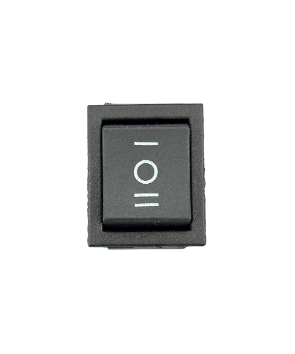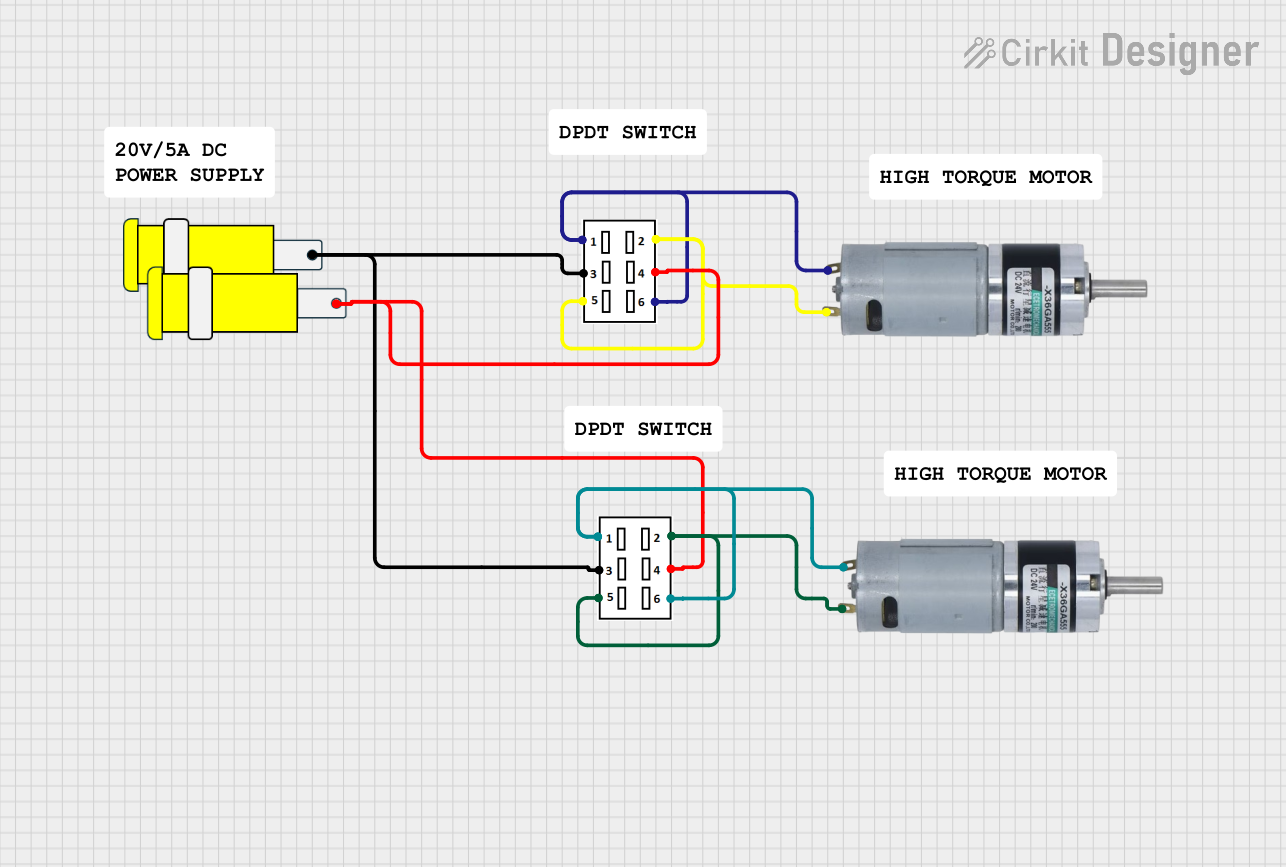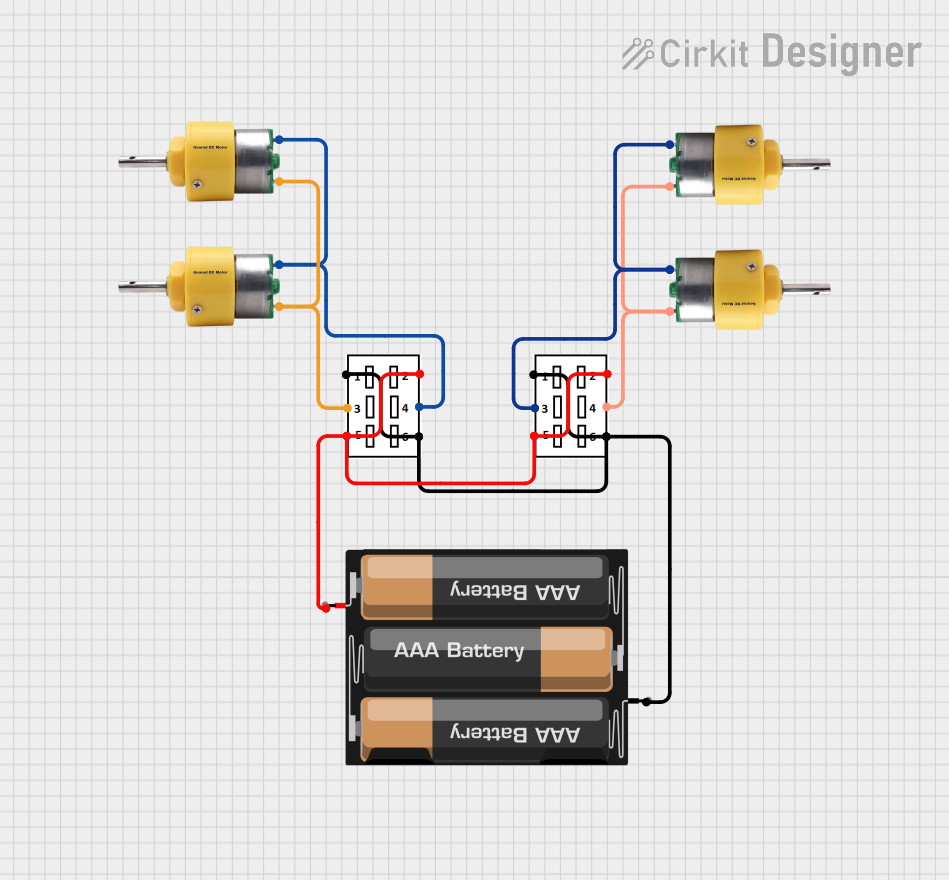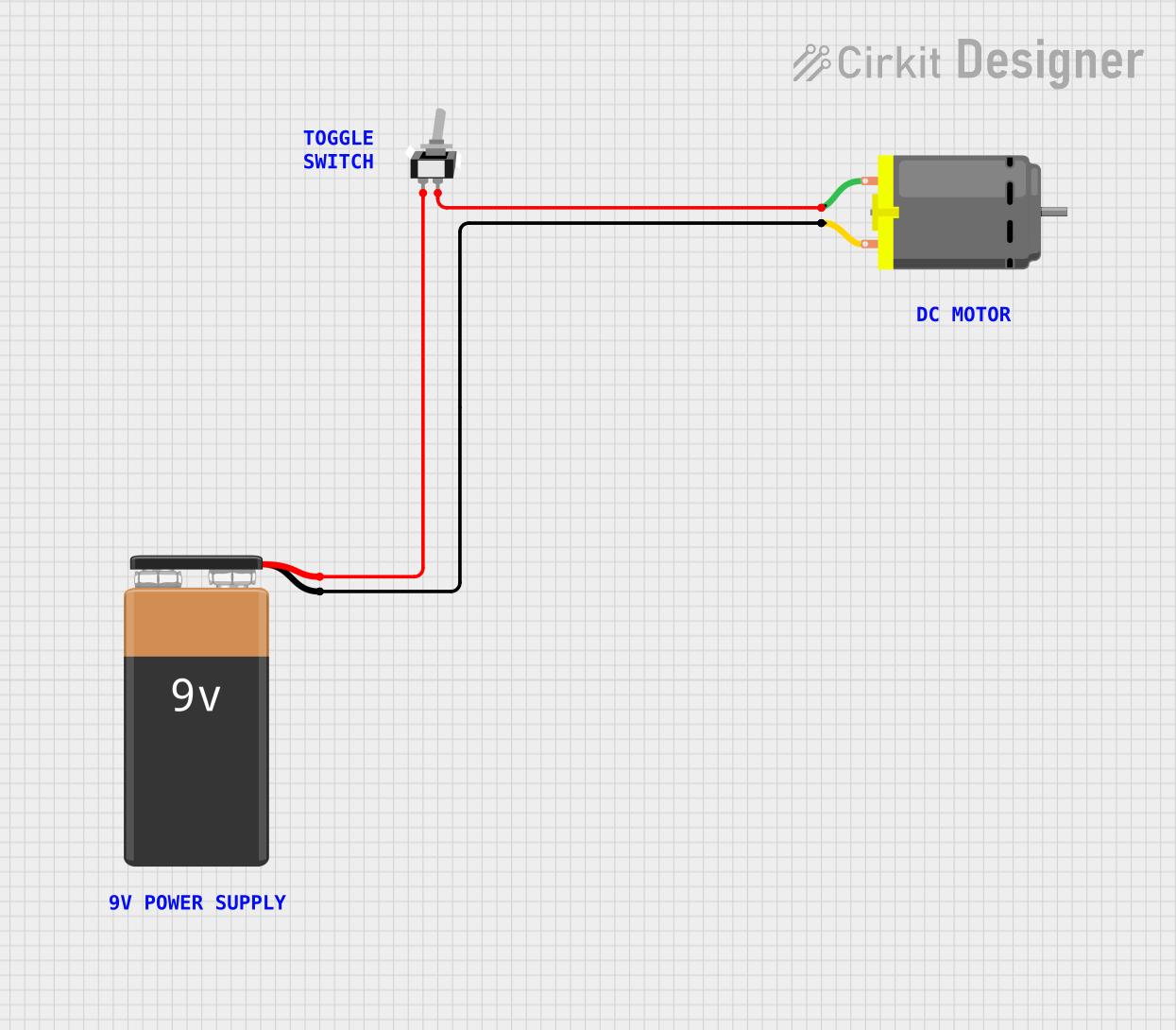
How to Use DPDT Switch: Examples, Pinouts, and Specs

 Design with DPDT Switch in Cirkit Designer
Design with DPDT Switch in Cirkit DesignerIntroduction
A Double Pole Double Throw (DPDT) switch is an electrical switch designed to control two separate circuits simultaneously. It features two input terminals and can connect each input to one of two outputs, making it highly versatile for applications requiring multiple control paths. DPDT switches are commonly used in motor control, reversing polarity, audio signal routing, and other applications where dual-circuit control is needed.
Explore Projects Built with DPDT Switch

 Open Project in Cirkit Designer
Open Project in Cirkit Designer
 Open Project in Cirkit Designer
Open Project in Cirkit Designer
 Open Project in Cirkit Designer
Open Project in Cirkit Designer
 Open Project in Cirkit Designer
Open Project in Cirkit DesignerExplore Projects Built with DPDT Switch

 Open Project in Cirkit Designer
Open Project in Cirkit Designer
 Open Project in Cirkit Designer
Open Project in Cirkit Designer
 Open Project in Cirkit Designer
Open Project in Cirkit Designer
 Open Project in Cirkit Designer
Open Project in Cirkit DesignerCommon Applications and Use Cases
- Motor Control: Reversing the direction of DC motors.
- Signal Routing: Switching between two audio or video sources.
- Polarity Reversal: Changing the polarity of a circuit.
- Power Distribution: Controlling two independent circuits with a single switch.
Technical Specifications
Below are the key technical details of a typical DPDT switch. Specifications may vary depending on the manufacturer and model.
General Specifications
- Switch Type: Double Pole Double Throw (DPDT)
- Number of Poles: 2
- Number of Throws: 2
- Voltage Rating: Typically 12V to 250V (AC or DC, depending on the model)
- Current Rating: 1A to 15A (varies by model)
- Contact Material: Silver, gold, or other conductive materials
- Actuation Type: Toggle, slide, rocker, or push-button
Pin Configuration and Descriptions
A DPDT switch typically has six terminals. The pin configuration is as follows:
| Pin Number | Label | Description |
|---|---|---|
| 1 | Input 1 (Pole 1) | First input terminal for the first circuit. |
| 2 | Output 1A | First output terminal for the first circuit (connected when the switch is ON). |
| 3 | Output 1B | Second output terminal for the first circuit (connected when the switch is OFF). |
| 4 | Input 2 (Pole 2) | Second input terminal for the second circuit. |
| 5 | Output 2A | First output terminal for the second circuit (connected when the switch is ON). |
| 6 | Output 2B | Second output terminal for the second circuit (connected when the switch is OFF). |
Usage Instructions
How to Use the DPDT Switch in a Circuit
- Identify the Terminals: Locate the six terminals on the switch. Refer to the pin configuration table above to understand their functions.
- Connect the Inputs: Connect the two input terminals (Pin 1 and Pin 4) to the power source or signal source.
- Connect the Outputs: Connect the output terminals (Pins 2, 3, 5, and 6) to the desired loads or circuits.
- Switch Operation: Toggle the switch to change the connection between the inputs and outputs. For example:
- In one position, Input 1 connects to Output 1A, and Input 2 connects to Output 2A.
- In the other position, Input 1 connects to Output 1B, and Input 2 connects to Output 2B.
Important Considerations and Best Practices
- Voltage and Current Ratings: Ensure the switch's voltage and current ratings match the requirements of your circuit.
- Debouncing: For applications involving digital signals, consider using a debouncing circuit to avoid signal noise caused by mechanical contacts.
- Mounting: Securely mount the switch to prevent accidental toggling or damage.
- Polarity: When reversing polarity in a DC circuit, double-check the connections to avoid short circuits.
Example: Using a DPDT Switch with an Arduino UNO
A DPDT switch can be used to reverse the direction of a DC motor. Below is an example circuit and Arduino code to control the motor direction using the switch.
Circuit Description
- Connect the DPDT switch to the motor and power supply as described in the pin configuration.
- Use the Arduino to monitor the switch's state and control the motor accordingly.
Arduino Code
// Define the input pins for the DPDT switch
const int switchPin1 = 2; // Pin connected to Output 1A
const int switchPin2 = 3; // Pin connected to Output 1B
// Define the motor control pins
const int motorPin1 = 9; // Motor terminal 1
const int motorPin2 = 10; // Motor terminal 2
void setup() {
// Set up the switch pins as inputs
pinMode(switchPin1, INPUT);
pinMode(switchPin2, INPUT);
// Set up the motor pins as outputs
pinMode(motorPin1, OUTPUT);
pinMode(motorPin2, OUTPUT);
}
void loop() {
// Read the state of the DPDT switch
bool switchState1 = digitalRead(switchPin1);
bool switchState2 = digitalRead(switchPin2);
// Control the motor direction based on the switch state
if (switchState1 == HIGH && switchState2 == LOW) {
// Forward direction
digitalWrite(motorPin1, HIGH);
digitalWrite(motorPin2, LOW);
} else if (switchState1 == LOW && switchState2 == HIGH) {
// Reverse direction
digitalWrite(motorPin1, LOW);
digitalWrite(motorPin2, HIGH);
} else {
// Stop the motor
digitalWrite(motorPin1, LOW);
digitalWrite(motorPin2, LOW);
}
}
Troubleshooting and FAQs
Common Issues
Switch Not Working:
- Cause: Loose or incorrect wiring.
- Solution: Double-check the connections and ensure the terminals are properly secured.
Overheating:
- Cause: Exceeding the switch's current or voltage rating.
- Solution: Use a switch with appropriate ratings for your circuit.
Signal Noise:
- Cause: Mechanical contact bounce.
- Solution: Add a debouncing circuit or use software debouncing in your microcontroller.
Motor Not Reversing:
- Cause: Incorrect wiring of the DPDT switch.
- Solution: Verify the connections to ensure proper polarity reversal.
FAQs
Q: Can I use a DPDT switch for AC circuits?
A: Yes, as long as the switch's voltage and current ratings are suitable for the AC circuit.Q: How do I know which terminal is which?
A: Refer to the datasheet or use a multimeter to identify the connections.Q: Can I use a DPDT switch to control LEDs?
A: Yes, but ensure the LEDs are connected with appropriate resistors to limit current.
By following this documentation, you can effectively use a DPDT switch in your projects and troubleshoot common issues.